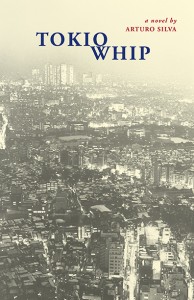JQ Magazine: Book Review — ‘Tokio Whip’

“Although Tokio Whip can be a difficult read, reading it actually resembles being in the city. You’ll learn things that are mind-blowing while wondering what exactly is going on.” (Stone Bridge Press)
By Rashaad Jorden (Yamagata-ken, 2008-10) for JQ magazine. A former head of the JETAA Philadelphia Sub-Chapter, Rashaad is a graduate of Leeds Beckett University with a master’s degree in responsible tourism management. For more on his life abroad and enthusiasm for taiko drumming, visit his blog at www.gettingpounded.wordpress.com.
Those who look fondly at their JET experience often feel that the people they met and the places they frequented greatly shaped their time in Japan. But as a lot of us—if not most of us—former JETs lived outside of the big cities, it might be interesting to read about how life in the capital might be influenced by people and places.
So Arturo Silva’s Tokyo Whip might just serve as a look at the capital that fascinates you. Silva, a native of the United States who spent the ‘80s and ‘90s in Tokyo, uses first person voice to take readers on a tour of the city experienced by Roberta and Lang, two Westerners living in the Japanese capital, and their friends. A story about life in Tokyo is probably interesting in itself. But another important story is brewing in Tokio Whip: Lang is a film director and he has created a 144-minute work divided into six scenes whose settlings include locations such as the Rikugien Garden, Seibu Ikebukuro Department Store, and Shinjuku Station—all of those being places you might be familiar with.
Most of Tokio Whip takes place in the heart of the city as Silva aims to create a novel similar to a tour of Tokyo people might go on. Even if the book really isn’t a circular tour of Tokyo, reading Tokio Whip will surely bring about some natsukashii moments or thoughts, such as one character who spent twenty minutes in Shinjuku Station looking for an exit or another character still getting lost in Shibuya Station despite being there hundreds of times.
But just like any tour of Tokyo, you’ll run into unexpected things in Tokio Whip—mainly accounts of moments in Japanese history and interesting people you may not have known about, such as Kazuyoshi Miura (a businessman charged with the murder of his wife) and Hazuko Hata (a woman who, in order to escape the countryside of Miyagi Prefecture, fabricated an incurable illness so that she could be sent to Tokyo, where she became involved in numerous sexual escapades).
However, it’s unclear how such stories enhanced Tokio Whip as those tales really aren’t relevant to contemporary life in Tokyo or the experiences of Roberta, Lang, and their friends. “Whip” seems to be an appropriate word to appear in the title as Silva bounces from the main characters to ramblings about life in Tokyo to a historical tale (as well as a poem). The novel isn’t the easiest read because Silva never really develops a flow that grips readers. There should be more focus on the main characters. Furthermore, the novel contains a lot of confusing dialogue. While a novel should naturally contain a lot of dialogue, considering that a crucial part of Tokio Whip is that Lang is creating a film, Silva really could have done a better job of making it clear who was speaking, because in long conversations, the speakers are not listed.
But during all the bouncing back and forth in Tokio Whip, moments can be found that might draw a chuckle out of you. At one point in the story, Lang hands a note to a young man named Cafferty containing a list of notes about bridges in Tokyo, which included some interesting—if not hilarious—translations, such as Shirahigehashi (“White Whiskers Bridge”) and Kototoibashi (“Asking for Word Bridge”). And there in only-in-Japan moments, such as a shopkeeper apologizing to a mother for having been foolish enough to place a cup or a vase (a character named Arlene was unable to specify which object while telling the story) in the vicinity of a child, who broke the object.
Although Tokio Whip can be a difficult read, reading it actually resembles being in the city. You’ll learn things that are mind-blowing while wondering what exactly is going on.
For more on Tokio Whip, click here. For more JQ magazine book reviews, click here.


Comments are closed.